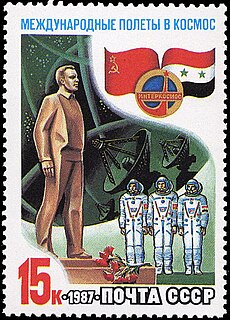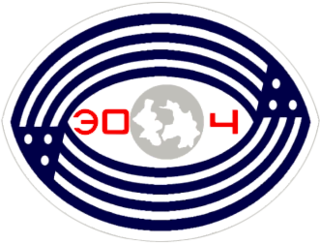
Mir was a space station that operated in low Earth orbit from 1986 to 2001, operated by the Soviet Union and later by Russia. Mir was the first modular space station and was assembled in orbit from 1986 to 1996. It had a greater mass than any previous spacecraft. At the time it was the largest artificial satellite in orbit, succeeded by the International Space Station (ISS) after Mir's orbit decayed. The station served as a microgravity research laboratory in which crews conducted experiments in biology, human biology, physics, astronomy, meteorology, and spacecraft systems with a goal of developing technologies required for permanent occupation of space.

Claudie (André-Deshays) Haigneré is a French doctor, politician and former astronaut with the Centre National d'Études Spatiales (1985–1999) and the European Space Agency (1999–2002).

Aleksandr "Sasha" Yuriyevich Kaleri is a Russian cosmonaut and veteran of extended stays on the Mir Space Station and the International Space Station (ISS). Kaleri has most recently been in space aboard the ISS serving as a flight engineer for the long duration Expedition 25/26 missions. He has spent the fourth-longest time in space of any person, the longest time in space of any currently active cosmonaut, and the longest time in space of any person not born in what is now Russia.

Yuri Pavlovich Gidzenko is a Russian cosmonaut. He was a test cosmonaut of the Yuri Gagarin Cosmonaut Training Center (TsPK). Gidzenko has flown into space three times and has lived on board the Mir and the International Space Station. He has also conducted two career spacewalks. Although he retired on July 15, 2001, he continued his employment by a special contract until Soyuz TM-34 concluded. Since 2004 to May 2009, Gidzenko was the Director of the 3rd department within the TsPK. Since May 2009 he serves as the Deputy Chief of Cosmonaut Training Center TsPK.

Valery Grigoryevich Korzun is a Russian cosmonaut. He has been in space twice totalling 381 days. He has also conducted four career spacewalks.

Col. Yuri Ivanovich Onufrienko is a retired Russian cosmonaut. He is a veteran of two extended spaceflights, aboard the space station Mir in 1996 and aboard the International Space Station in 2001–2002.

Anatoly Yakovlevich Solovyev is a retired Russian and Soviet cosmonaut and pilot. Solovyev was born on January 16, 1948, in Riga, Latvia. Solovyev holds the world record on the number of spacewalks performed (16), and accumulated time spent spacewalking.

Yury Vladimirovich Usachov is a former cosmonaut who resides in Star City, Moscow. Usachov is a veteran of four spaceflights, including two long duration missions on board the Mir Space Station and another on board the International Space Station. During his career, he also conducted seven spacewalks before his retirement on April 5, 2004.

Soyuz TM-2 was a crewed spaceflight to the Soviet space station Mir, which was uncrewed at the time. TM-2 was launched on February 5, 1987, and it was first crewed spaceflight of the Soyuz-TM spacecraft, and the second crewed spaceflight to Mir. The crew of the long duration expedition, Mir EO-2, who were launched by TM-2 consisted of Soviet cosmonauts Yuri Romanenko and Aleksandr Laveykin.

Soyuz TM-3 was the third crewed spaceflight to visit the Soviet space station Mir, following Soyuz T-15 and Soyuz TM-2. It was launched in July 1987, during the long duration expedition Mir EO-2, and acted as a lifeboat for the second segment of that expedition. There were three people aboard the spacecraft at launch, including the two man crew of the week-long mission Mir EP-1, consisting of Soviet cosmonaut Aleksandr Viktorenko and Syrian Muhammed Faris. Faris was the first Syrian to travel to space, and as of June 2021, the only one. The third cosmonaut launched was Aleksandr Aleksandrov, who would replace one of the long duration crew members Aleksandr Laveykin of Mir EO-2. Laveykin had been diagnosed by ground-based doctors to have minor heart problems, so he returned to Earth with the EP-1 crew in Soyuz TM-2.

Soyuz TM-4 was a crewed Soyuz spaceflight to Mir. It was launched on 21 December 1987, and carried the first two crew members of the third long duration expedition, Mir EO-3. These crew members, Vladimir Titov and Musa Manarov, would stay in space for just under 366 days, setting a new spaceflight record. The third astronaut launched by Soyuz TM-4 was Anatoli Levchenko, who returned to Earth about a week later with the remaining crew of Mir EO-2. Levchenko was a prospective pilot for the Soviet Space shuttle Buran. The purpose of his mission, named Mir LII-1, was to familiarize him with spaceflight.

Soyuz TM-6 was a crewed Soyuz spaceflight to Mir. It was launched on 29 August 1988, at 04:23:11 UTC, for the station's third long-duration expedition, Mir EO-3. The three-person crew that was launched consisted of Research Doctor Valeri Polyakov, who became part of the EO-3 crew, as well as the two crew members of the week-long mission Mir EP-3, which included the first ever Afghan cosmonaut, Abdul Ahad Mohmand.

Soyuz TM-23 was a Soyuz spaceflight which launched on February 21, 1996, to Mir. The spacecraft launched from Baikonur Cosmodrome, and after two days of flight, Yuri Onufrienko and Yury Usachov docked with Mir and became the 21st resident crew of the Station. On September 2, 1996, after 191 days docked with Mir, the ship undocked with the launch crew and Claudie André-Deshays onboard, before eventually landing 107 km (66 mi) south west of Akmola, Kazakhstan.

Soyuz TM-24 was the 27th expedition to Mir. Soyuz TM-24 carried a crew of three. The crew consisted of Cosmonauts Valery Korzun and Aleksandr Kaleri, and the first French woman in space, Claudie André-Deshays. They joined American astronaut Shannon Lucid and Mir 21 crewmates Yuri Onufriyenko and Yuri Usachev. André-Deshays carried out biological and medical experiments on Mir for 16 days before returning to Earth with Onufriyenko and Usachev.

Expedition 2 was the second long-duration spaceflight aboard the International Space Station, immediately following Expedition 1. Its three-person crew stayed aboard the station from March to August 2001. In addition to station maintenance, the crew assisted in several station assembly missions, welcomed the first space tourist Dennis Tito, and conducted some scientific experiments.

The Shuttle–Mir program was a collaborative 11-mission space program between Russia and the United States that involved American Space Shuttles visiting the Russian space station Mir, Russian cosmonauts flying on the Shuttle, and an American astronaut flying aboard a Soyuz spacecraft to engage in long-duration expeditions aboard Mir.
Mir EO-3 was an expedition to the space station Mir. The crew consisted of 3 people, Musa Manarov (Commander), Vladimir Titov and Valeri Polyakov. Manarov and Titov arrived at the station in December 1987 on Soyuz TM-4, while Polyakov arrived much later, in August 1988 on Soyuz TM-6. After the arrival of Polyakov, medical experiments became more intensive.

Mir EO-4 was the fourth long-duration expedition to the Soviet space station Mir. The expedition began in November 1988, when crew members Commander Aleksandr Volkov and Flight Engineer Sergei Krikalev arrived at the station via the spacecraft Soyuz TM-7. The third crew member of EO-4, Valeri Polyakov, was already aboard Mir, having arrived in August 1988 part way through the previous expedition, Mir EO-3.

Mir EP-2 was a visiting expedition to the Mir space station conducted in June 1988 by cosmonauts Anatoly Solovyev, Viktor Savinykh and Aleksandr Aleksandrov. Launched aboard the Soyuz TM-5 spacecraft, the crew spent ten days in space before returning to Earth aboard Soyuz TM-4. The mission occurred while the EO-3 crew were aboard Mir.

Mir EO-19 was the nineteenth crewed expedition to the space station Mir, lasting from June to September 1995. The crew, consisting of Russian cosmonauts Anatoly Solovyev and Nikolai Budarin, launched on June 27, 1995 aboard the Space Shuttle Atlantis on the STS-71 mission. After remaining aboard Mir for approximately 75 days, Solovyev and Budarin returned aboard the Soyuz TM-21 spacecraft on September 11, 1995.




















